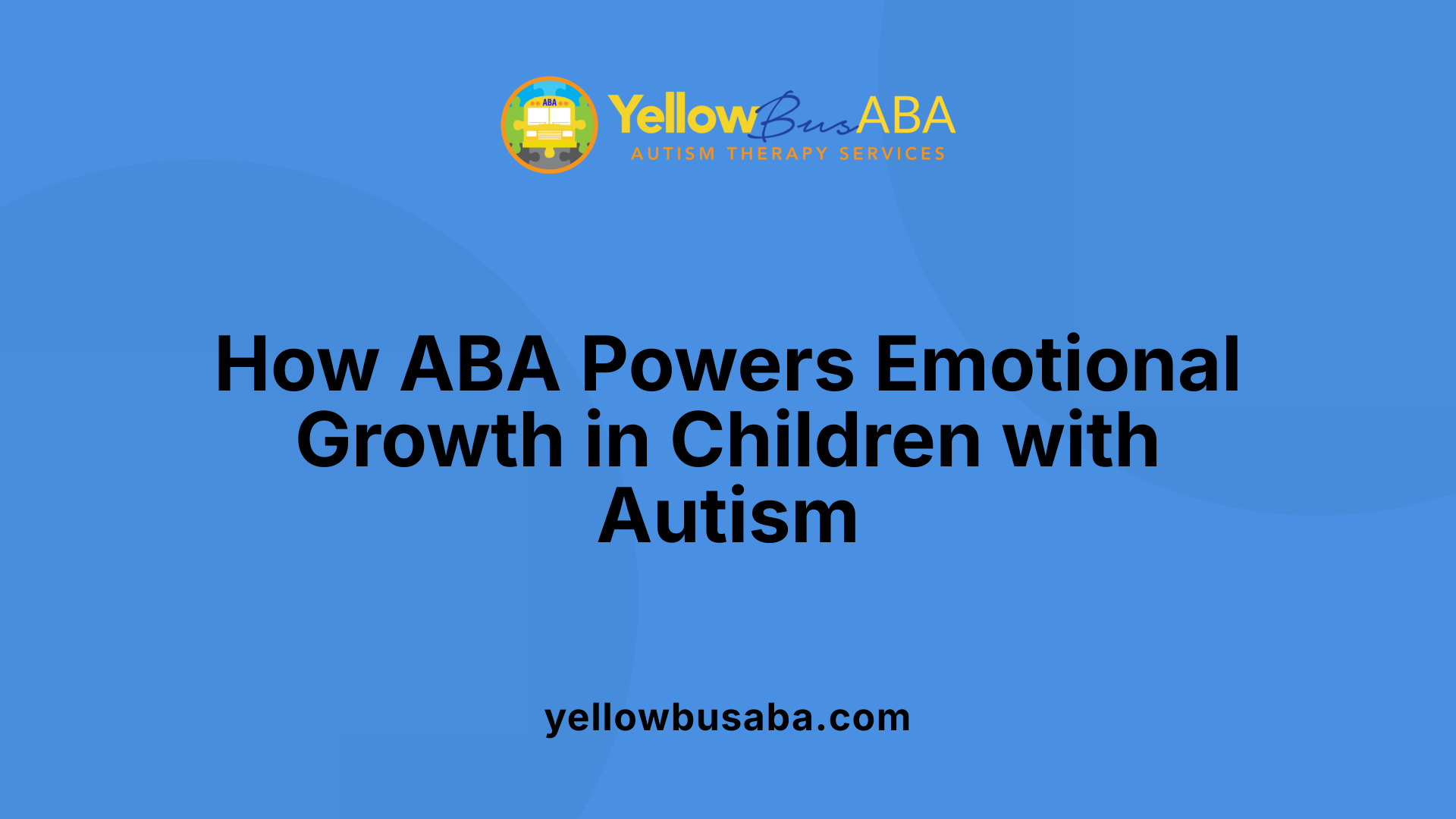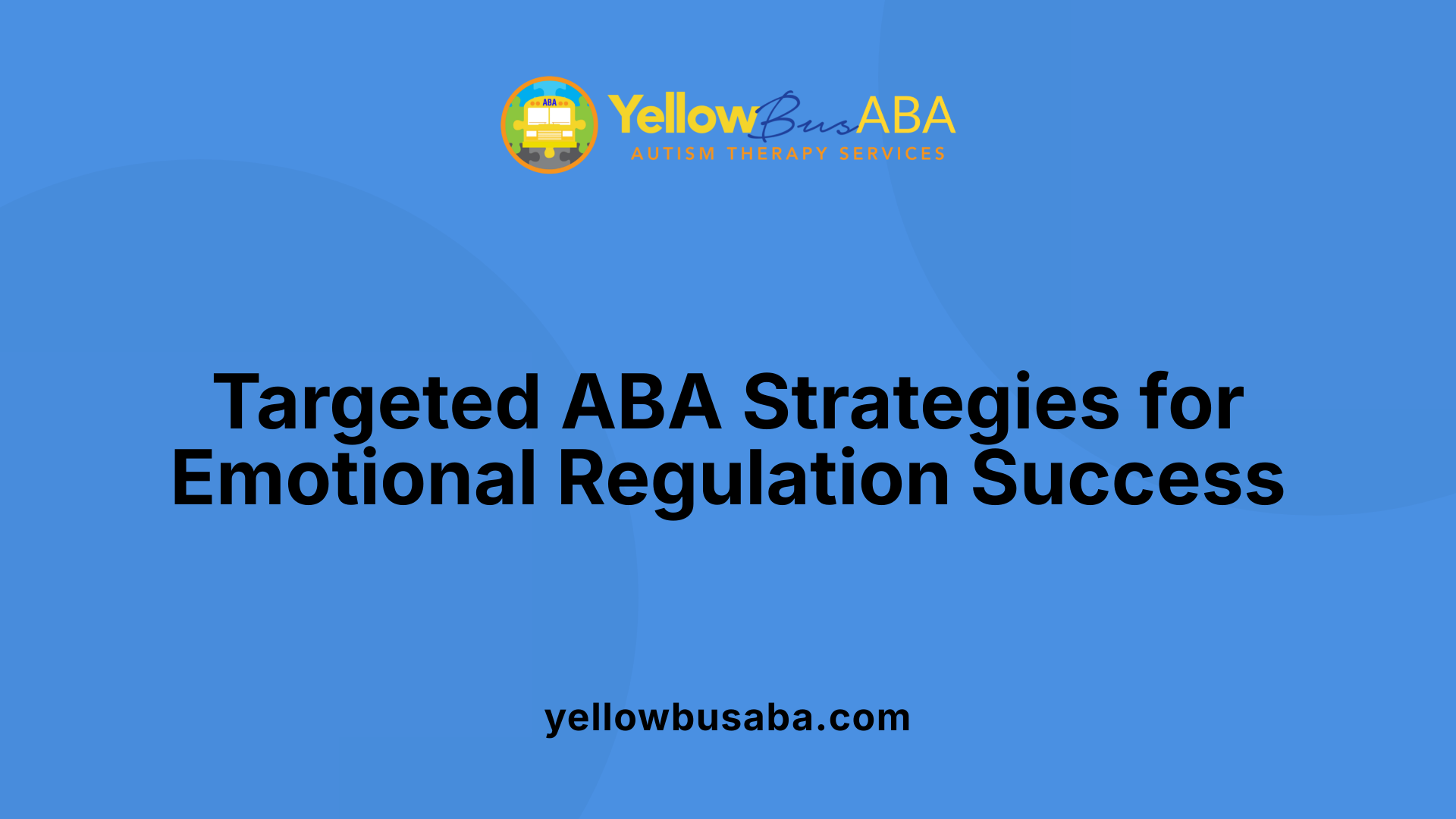Understanding ABA’s Vital Role in Emotional Development for Autistic Children
Applied Behavior Analysis (ABA) is renowned as an effective, evidence-based therapeutic approach for children with autism spectrum disorder (ASD). Its structured interventions focus on fostering social, communicative, and daily life skills. Of particular importance is ABA’s capacity to support emotional regulation, a critical component for improving overall functioning, social interactions, and quality of life in autistic children. This article explores how ABA therapy teaches emotional regulation skills, the techniques employed, evidence of its effectiveness, and its impact on social and emotional growth.
The Fundamental Role of ABA in Teaching Emotional Regulation

Why is ABA important in emotional development for children with autism?
ABA (Applied Behavior Analysis) is a highly regarded therapeutic approach that significantly impacts the emotional growth of children with autism. It helps children understand and manage their feelings by building skills such as emotional awareness, regulation, and flexibility. Through structured and consistent interventions, ABA enhances their ability to respond appropriately to various emotional situations, ultimately supporting overall mental health and social harmony.
Children with autism often face challenges in recognizing, expressing, and controlling their emotions. ABA addresses these struggles by encouraging positive emotional behaviors and teaching children practical coping strategies. As a result, children become better able to handle stress, anxiety, and frustration, leading to improved interactions with others and increased independence.
How does ABA structured intervention support teaching emotional regulation?
ABA uses a variety of techniques tailored to each child's individual needs. Its structured approach involves clear goals, routine, and reinforcement strategies that motivate children to learn and practice emotional skills.
Key components include:
- Use of visual aids such as emotion charts or social stories to teach recognition of feelings.
- Modeling desirable responses to emotional triggers.
- Role-playing scenarios for practicing appropriate reactions.
- Teaching calming techniques like deep breathing or taking breaks.
- Reinforcing positive behaviors with praise or rewards.
This predictable, supportive environment allows children to safely explore and develop emotional control, which can be transferred across different settings, including home, school, and social groups.
How does ABA facilitate emotional growth?
Through consistent reinforcement and skill-building activities, ABA encourages children to identify their emotions, label them accurately, and respond in socially acceptable ways. It promotes emotional flexibility—helping children adapt their responses depending on the context.
Furthermore, ABA teaches children to recognize emotional triggers, understand social cues, and develop self-regulation strategies. These skills are crucial for reducing anxiety and managing reactions like temper tantrums or withdrawal.
Parental involvement is also vital; caregivers are engaged in the process, learning how to support emotional regulation outside therapy sessions.
Long-term benefits of ABA in emotional regulation
Research indicates that children undergoing ABA therapy experience improved emotional resilience, better social interactions, and greater independence. These improvements contribute to a higher quality of life and smoother integration into various social environments.
In summary, ABA’s structured, evidence-based techniques are integral in teaching children with autism how to understand, express, and control their emotions. This not only enhances their current emotional wellbeing but also lays a foundation for lifelong social and emotional success.
Techniques and Methods Used in ABA to Foster Emotional Regulation
 ABA therapy incorporates a variety of structured and evidence-based methods specifically aimed at improving emotional regulation in children with autism. Visual supports such as emotion charts and social stories are commonly used to help children recognize and understand their own feelings as well as social cues. These tools make emotions more concrete, aiding in self-awareness and fostering emotional intelligence.
ABA therapy incorporates a variety of structured and evidence-based methods specifically aimed at improving emotional regulation in children with autism. Visual supports such as emotion charts and social stories are commonly used to help children recognize and understand their own feelings as well as social cues. These tools make emotions more concrete, aiding in self-awareness and fostering emotional intelligence.
Modeling and role-playing exercises are also vital components. Therapists demonstrate appropriate responses to various emotional situations, enabling children to imitate these behaviors in a safe environment. Through repeated practice, children learn to manage their reactions better and develop social skills essential for everyday interactions.
Positive reinforcement strategies play a significant role in emotional development. When children successfully regulate their emotions or respond appropriately, they receive praise or rewards. This positive feedback encourages continued effort and helps embed emotional regulation as a natural part of their behavior.
Teaching calming and coping strategies is another crucial element. Children are introduced to techniques such as deep breathing, sensory tools, and problem-solving methods to handle emotional triggers. Recognizing triggers early and applying specific calming strategies can significantly reduce anxiety, frustration, and outbursts.
Functional Communication Training (FCT) is used to teach children effective ways to express their feelings and needs verbally or through alternative communication methods. This reduces the likelihood of emotional outbursts driven by frustration or inability to communicate.
Consistent application of these techniques across therapy sessions and at home supports ongoing emotional growth. Therapists work with families to identify individual triggers and develop personalized strategies. Overall, these approaches foster emotional resilience, improve social interactions, and promote a healthier emotional outlook in children with autism.
Effectiveness of ABA in Developing Emotional Regulation Skills

How effective is ABA therapy in supporting emotional regulation development in children with autism?
Research shows that ABA therapy is a powerful tool in helping children with autism improve their emotional regulation. Through structured programs, children learn to recognize their emotions, understand triggers, and develop appropriate responses. Techniques like visual aid tools such as emotion cards and mood meters, modeling emotional responses, and practicing calming strategies like deep breathing all contribute to this progress.
ABA therapy promotes self-control by teaching children to pause and think before reacting and by encouraging behaviors that help manage anxiety and frustration. Structured reinforcement of positive emotional responses helps children develop healthier ways to cope with challenging situations.
While ABA is well-known for advancing social and communication skills, evidence also supports its role in emotional growth. Especially when interventions are early and intensive, children tend to show notable improvements in emotional awareness and flexibility. For instance, they become more adept at managing stress and demonstrating adaptive reactions, which support better social interactions.
However, some research highlights the need for further studies to fully understand ABA's impact on core emotional regulation abilities across all children with autism. Despite this, the structured and data-driven nature of ABA therapy ensures it remains a trusted approach for fostering emotional resilience and stability.
In summary, ABA therapy offers meaningful benefits for developing emotional regulation in children with autism, complementing its known strengths in improving social and communication skills.
Impact of ABA on Social and Emotional Skills

What impact does ABA therapy have on emotional and social skills in children with autism?
Applied Behavior Analysis (ABA) is renowned for its positive influence on the social and emotional development of children with autism spectrum disorder (ASD). Structured ABA programs focus on teaching children how to interpret social cues, communicate effectively, and regulate their emotions.
Through techniques like Discrete Trial Training, Natural Environment Teaching, role-playing, and social skills groups, ABA helps children understand facial expressions, body language, and non-verbal signals. These skills are vital for social interactions and forming relationships.
Children learn to engage in reciprocal conversations, showing improvements in sharing attention, responding to others, and demonstrating empathy. The therapy's individualized approach ensures that each child receives tailored support to develop these competencies.
A significant benefit of ABA is the ability to help children apply their social and emotional skills across different environments, such as home, school, and community settings.
Research consistently indicates that children undergoing ABA therapy experience notable gains in their social interactions, emotional understanding, and self-awareness. These improvements contribute to increased independence and active participation in social activities.
Overall, ABA fosters meaningful progress in emotional and social functioning for children with ASD, laying a strong foundation for their ongoing development and integration into broader social contexts.
Specialized Therapeutic Approaches within ABA to Improve Emotional Regulation

Are there specific therapeutic approaches within ABA aimed at improving emotional regulation in autistic children?
Yes, ABA employs targeted strategies to help children with autism better understand and manage their emotions. Visual supports, such as emotion cards and visual emotion charts, are used to help children recognize different feelings like sadness, anger, or excitement. These visual aids make abstract emotions more concrete and accessible.
Social stories are tailored narratives that teach children how to respond to social situations and regulate emotions appropriately. For example, a story might illustrate steps to calm down when feeling overwhelmed or how to express frustration calmly.
Emotion recognition training is another component that enhances awareness of emotional cues. Therapists guide children through exercises that involve identifying emotions from facial expressions, body language, or tone of voice, fostering better social interactions.
In addition to recognition, developing coping mechanisms is essential. Relaxation techniques such as deep breathing, taking breaks, and progressive muscle relaxation are taught to help children self-soothe during heightened emotional states.
Self-calming methods include strategies like counting to ten, using sensory objects, or engaging in calming activities, which enable children to gain control over their feelings.
Positive reinforcement plays a crucial role by rewarding children when they successfully use coping strategies or exhibit emotional regulation behaviors. This reinforcement encourages continued effort and success.
Consistency is vital. When these techniques are applied both in therapy sessions and at home, children receive a unified approach that reinforces learning and promotes generalization.
By integrating visual supports, storytelling, emotion recognition, and coping skills, ABA helps children with autism to better navigate their emotional experiences. These approaches reduce behavioral difficulties related to emotional dysregulation and support healthier social functioning.
The overall goal of these methods is to foster emotional resilience, decrease anxiety, and promote adaptive responses that enhance their daily lives and social relationships.
Research Findings and Evidence Supporting ABA’s Role in Emotional Regulation
What does research say about the role of ABA therapy in emotional regulation?
Studies consistently show that ABA therapy is highly effective in helping children with autism spectrum disorder (ASD) develop emotional regulation skills. These skills are essential for managing feelings like frustration, anxiety, and anger, which often challenge children with ASD.
Research indicates that ABA interventions improve children’s ability to recognize, understand, and express emotions. This is achieved through techniques such as visual supports, modeling, and behavioral training. For example, visual emotion charts and social stories are used to teach children how to identify their feelings and respond appropriately, leading to better social interactions.
Early and intensive ABA programs are particularly impactful. They help children develop receptive and expressive language—fundamental for understanding and communicating emotions. These improvements not only reduce challenging behaviors but also foster resilience and emotional flexibility.
Data collection plays a vital role in tracking progress. Continuous monitoring using tools like the Mood Meter or emotion cards allows therapists to adjust strategies and ensure measurable gains in emotional regulation.
One notable program, ReLACS, illustrates how parent-mediated ABA interventions can be both cost-effective and accessible. Such programs empower families to reinforce emotional skills at home, enhancing learning and stability.
Overall, scientific evidence supports ABA as a cornerstone in emotional development for children with ASD. It provides a structured approach to help children better manage their emotional world, which leads to improved social relationships and increased independence.
Transforming Lives with Structured Emotional Growth
In summary, ABA therapy stands as a cornerstone intervention in promoting emotional regulation in children with autism. Its evidence-based methods, tailored strategies, and focus on skill generalization enable children to better understand, manage, and express their emotions, fostering greater social participation, independence, and resilience. As research continues to affirm its effectiveness, ABA remains integral to comprehensive autism support, helping young learners navigate their emotional worlds and thrive in diverse environments.
References
- The effectiveness of applied behavior analysis program training on ...
- The Importance of ABA Therapy in Supporting Emotional Regulation
- How ABA Therapy Helps Children with Autism Thrive
- Teaching Emotional Intelligence with ABA - Therapyland
- ABA Therapy Can Prepare Your Child with Autism for Music Lessons!
- ABA Therapy's Role in Emotional Regulation
- From Meltdowns to Calm:ABA Therapy Strategies for Managing ...






